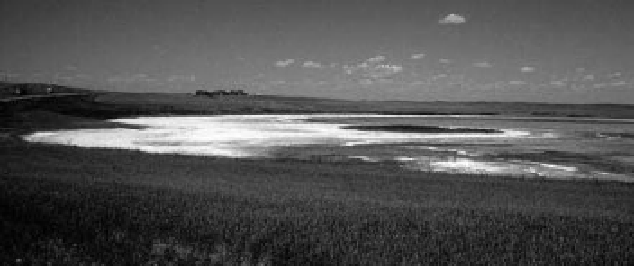Geoscience Reference
In-Depth Information
Figure 16-34.
Partly dry alkali lake with salt l at, Cactus Hills, southern Saskatchewan, Canada. Photo by J.S. Aber.
from national, provincial, and local agencies as
well as non-governmental organizations, such
as Ducks Unlimited Canada and the Nature
Conservancy of Canada. This plan has proven
highly successful; through 2009, US$4.5 billion
had been spent to protect more than 625,000 ha
of wetland habitat (NAWMP 2009). The prairie
pothole region was recognized as a high-priority
transnational area in which conservation efforts
were much needed (Larsen 1991). As part of
the NAWMP, the Saskatchewan Watershed
Authority has converted 7000 ha of cropland to
pasture or permanent ground cover in the Mis-
souri Coteau region (Saskatchewan Water
Authority 2011).
The Chaplin-Old Wives-Reed Lakes complex
west and southwest of Moose Jaw has been
designated as a site of hemispheric importance
by the Western Hemispheric Shorebird Reserve
Network (WHSRN 2009). In this case, recogni-
tion was based on
Figure 16-35.
Sanderling (
Calidris alba
) at Farallon,
Panama in winter. This individual might well migrate
on the Great Plains l yway via Old Wives Lake,
Saskatchewan, Canada. Adapted from original color
photo by Mdf; obtained from Wikipedia Commons
<
http://commons.wikimedia.org/
>
.
>
100,000 shorebirds visiting
waterfowl and shorebirds as well as other l ora
and fauna.
>
annually and
30 percent of all sanderlings
(
Calidris alba
) using the site as a spring migra-
tion stopover (Fig. 16-35). In addition, several
wetland sites in the Missouri Coteau of Sas-
katchewan are designated as Important Bird
Areas, including Old Wives-Frederick Lakes,
Chaplin Lake, Big Muddy Lake, Willow Bunch
Lake, and others (Nature Saskatchewan 2010).
These non-governmental efforts involve a com-
bination of public and private lands, which may
or may not overlap with legally protected areas.
Such multiple international and local efforts
have led to signii cant wetland restoration and
preservation in the Missouri Coteau region,
which have greatly benei tted
16.3 Coastal wetlands of Maine and
Massachusetts, United States
Tidal salt, brackish and fresh-water marshes
occur across coastal regions in the upper lati-
tudes beyond the mangrove-dominated subtrop-
ics. Sheltered estuarine and delta regions along
the New England coastline provide the right
conditions for marsh development. These highly
productive systems are dominated by grasses in
low-lying tidally inundated zones near estuaries,
sheltered bays and coves, inlets, creeks and
migrating







